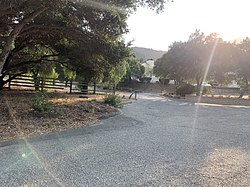- Las Cruces Hotel advertised its proximity to Las Cruces Hot Springs and Nojoqui Falls (The Lompoc Record, Dec. 18, 1880)
- Las Cruces, California location map submitted to the U.S. Post Office Department in 1885
Las Cruces, California | |
|---|---|
 Las Cruces, August 2021 | |
| Coordinates: 34°30′29″N120°13′45″W / 34.50806°N 120.22917°W | |
| Country | United States |
| State | California |
| County | Santa Barbara |
| Elevation | 341 ft (104 m) |
| Time zone | UTC-8 (Pacific (PST)) |
| • Summer (DST) | UTC-7 (PDT) |
| Area codes | 805 & 820 |
| GNIS feature ID | 1660894 [1] |
Las Cruces (sometimes rendered Las Cruses, meaning the crosses in Spanish) [2] is a former settlement and an archaic placename in Santa Barbara County, California. [1] It lies at the split between California State Route 1, which travels north to Lompoc, and U.S. Route 101, which travels north to Buellton. The two routes coincide on the highway to the south through the Gaviota Gorge to the Gaviota Coast. The community lies within area code 805.



